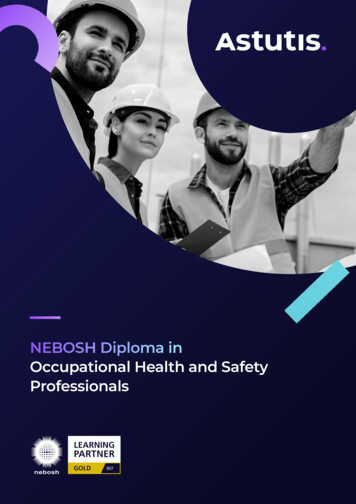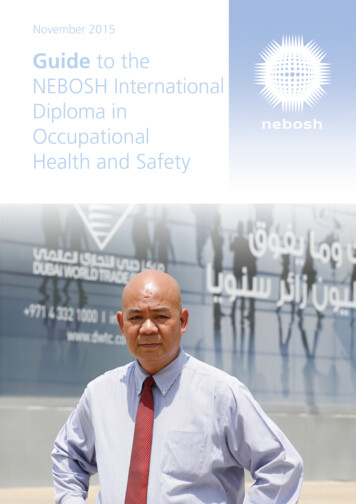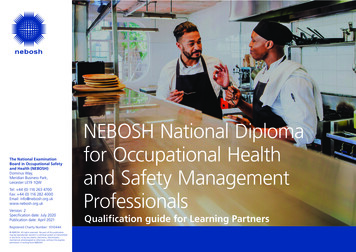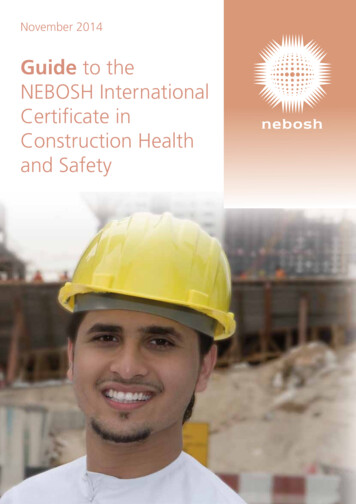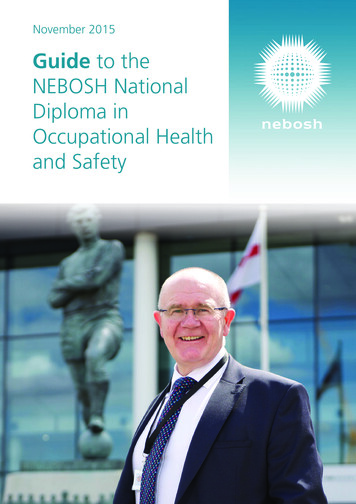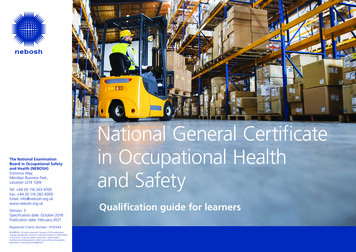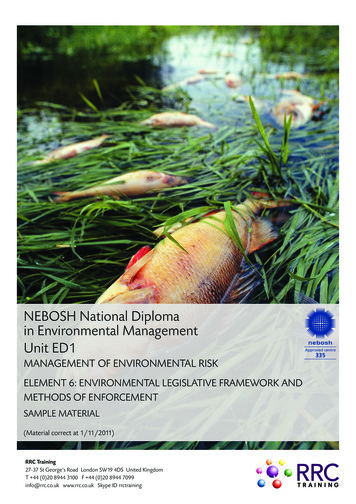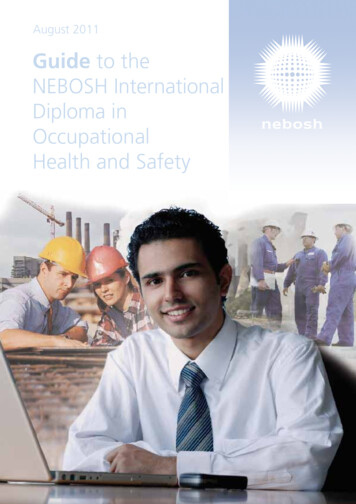
Transcription
August 2011Guide to theNEBOSH InternationalDiploma inOccupationalHealth and Safety
Qualification title: NEBOSH International Diploma in Occupational Health and SafetyVersion: 7Specification date: August 2011Guide publication date: September 2014The National Examination Board in Occupational Safety and Health (NEBOSH),Dominus Way, Meridian Business Park, Leicester LE19 1QW.Registered Charity Number: 1010444Telephone:Fax:Email:Website: 44 (0) 116 263 4700 44 (0) 116 282 4000info@nebosh.org.ukwww.nebosh.org.uk NEBOSHAll rights reserved. No part of this publication may be reproduced, stored in a retrieval system ortransmitted in any form, or by any means, electronic, electrostatic, mechanical, photocopied orotherwise, without the express permission in writing from NEBOSH. NEBOSH 2014IDip 260814 v7
Guide to the NEBOSH International Diploma ion)Contents1.2.3.4.Introduction1.1 Benefits for employers1.2 Designatory letters1.3 Professional membership1.4 Qualification level and UK accreditation1.5 Key topics covered1.6 Course tuition and private study time requirements1.7 Entry requirements1.8 Minimum standard of English required for candidates1.9 Legislation1.10 Legislative updates1.11 National Occupational Standards (NOS) and best practice1.12 Qualification type1.13 Qualification progression1.14 Programmes offered by NEBOSH-accredited course providers1.15 Examination dates1.16 Specification date1.17 Syllabus development and review1.18 Further information for candidates1.19 Further information for accredited course providers1222233344445555556Qualification structure2.1 Unit assessment2.2 Achieving the qualification2.4 Unit pass standard2.5 Unit certificates2.6 Qualification grades2.7 Qualification parchments2.8 Re-sitting examinations7899999Policies3.1 Requests for access arrangements/reasonable adjustments3.2 Requests for special consideration3.3 Enquiries about results and appeals3.4 Malpractice11111112Syllabus - NEBOSH International Diploma in Occupational Health and Safety(August 2011 specification)13 NEBOSH 2014
4.1: Unit IA:Element IA1:Element IA2:Element IA3:Element IA4:Element IA5:Element IA6:Element IA7:Element IA8:International management of health and safetyPrinciples of health and safety managementLoss causation and incident investigationMeasuring and reviewing health and safety performanceIdentifying hazards, assessing and evaluating risksRisk ControlOrganisational factorsHuman factorsRegulating health and safety4.2 Unit IB:Element IB1:Element IB2:Element IB3:1721232527293235International control of hazardous agents in the workplacePrinciples of chemical control, toxicology and epidemiologyHazardous substances and other chemicals – assessment of riskHazardous chemicals – engineering controls and personal protectiveequipmentElement IB4: Monitoring and measuringElement IB5: Biological agentsElement IB6: Physical agents 1 – noise and vibrationElement IB7: Physical agents 2 – radiationElement IB8: Psycho-social agentsElement IB9: Musculoskeletal risks and controlsElement IB10: Work environment risks and controlsElement IB11: Managing occupational health4.3 Unit IC:Element IC1:Element IC2:Element IC3:Element IC4:Element IC5:Element IC6:Element IC7:Element IC8:Element IC9:Element IC10:Element IC11:International workplace and work equipment safetyGeneral workplace issuesPrinciples of fire and explosionWorkplace fire risk assessmentStorage, handling and processing of dangerous substancesWork equipment (general)Work equipment (workplace machinery)Work equipment (mobile, lifting and access)Electrical safetyConstruction hazards and controlsWorkplace transport and driving for workPressure system hazards and 914.2 Unit ID:Application of international health and safety theory and practice4.2.1 Purpose and aim934.2.2 Marking944.2.3 Assessment location944.2.4 Submission of completed work944.2.5 Further information945.Sample examination question papers5.1 Unit IA: International management health and safety5.2 Unit IB: International control of hazardousagents in the workplace5.3 Unit IC: International workplace and work equipmentsafety NEBOSH 20149599103
NEBOSH International Diploma in Occupational Health and Safety(August 2011 specification)1.IntroductionThe NEBOSH International Diploma is the qualification for aspiring health and safetyprofessionals, building directly upon the foundation of knowledge provided by the NEBOSHInternational General Certificate. The Diploma is designed to provide students with theexpertise required to undertake a career as a safety and health practitioner and alsoprovides a sound basis for progression to postgraduate study.The NEBOSH National Diploma is the flagship NEBOSH qualification and is the first UKvocational qualification to be developed specifically for health and safety professionals.Since its introduction in 1988, the National Diploma has become established as the mostpopular professional qualification for safety and health practitioners in the UK, with over10,000 candidates having achieved the qualification.The International Diploma is modelled on the NEBOSH National Diploma in OccupationalHealth and Safety. The key difference between the two qualifications is in the applicability oflegal requirements. Rather than be guided by a specifically UK framework, the InternationalDiploma takes a risk management approach based on best practice and internationalstandards, such as International Labour Organisation (ILO) codes of practice, with specialreference to the model proposed in the ILO's "Guidelines on Occupational Safety and HealthManagement Systems" (ILO-OSH 2001). Local laws and cultural factors form part of thestudy programme where relevant and appropriate.1.1Benefits for employersDespite the increasing global recognition of the importance of health and safety at work,accidents and work-related ill-health continue to affect all types of workplaces andoccupations. The ILO estimates that 6,300 people die daily as a result of occupationalaccidents or work-related diseases - more than 2.3 million deaths worldwide per year. Atleast 10% of these deaths are due to the 337 million accidents at work that occur annually.There are an estimated 500 –2000 non-fatal injuries for every fatal injury (including 160million cases of work-related disease), many of which result in lost earnings, lost jobs andpermanent disability and poverty.In addition to the direct costs of sick pay and absence, employers can find themselvesdealing with criminal prosecution, claims for compensation, adverse publicity and harm toboth business reputation and profitability. In the UK alone, the estimated annual cost ofoccupational injury and illness in 2005/6 is 3 billion to UK employers and 13 billion to theBritish economy. In 2003, the ILO estimated the cost to the global economy at an estimated 1.25 trillion ( 1,250,000 million).The vast majority of workplace injuries, accidents and ill-health are avoidable by good healthand safety management. By saving money, improving productivity and raising workforcemorale, effective health and safety management should be recognised as an essentialelement of a successful management strategy.Management of health and safety in the workplace makes sound business sense. Qualifiedhealth and safety professionals are an asset to their organisations, reducing costs bypreventing accidents and ill health of workers, without incurring unnecessary expense byover-reacting to trivial risks. NEBOSH 20141
NEBOSH International Diploma in Occupational Health and Safety(August 2011 specification)Courses leading to the NEBOSH International Diploma may be taken in a variety of formatsand at a pace to fit around the needs of the business. Its unitised structure recognisessuccess as the student progresses. Its practical approach promotes the application of theknowledge acquired on the course to problem solving in the student’s own workplace.1.2Designatory lettersHolders of the NEBOSH International Diploma in Occupational Health and Safety may usethe designatory letters ‘IDipNEBOSH’ after their name.1.3Professional membershipThe qualification meets the academic requirements to apply for Graduate Membership (GradIOSH) of Institution of Occupational Safety and Health (IOSH – www.iosh.co.uk). This is thefirst step to becoming a Chartered Health and Safety Practitioner as a Chartered Member ofIOSH (CMIOSH).Holders of the NEBOSH International Diploma in Occupational Health and Safety and eitherthe NEBOSH National or International Certificate in Construction Health and Safety meet theheadline entrance criteria requirements for Registered Construction Safety Practitioner(RMaPS) membership of the Association for Project Safety (APS).The International Diploma is also accepted by the International Institute of Risk and SafetyManagement (IIRSM) as meeting the academic requirements for Full membership (MIIRSM).1.4Qualification level and UK accreditationThe NEBOSH International Diploma in Occupational Health and Safety is accredited andcredit rated by the Scottish Qualifications Authority (SQA - www.sqa.org.uk). It is ratedwithin the Scottish Credit and Qualifications Framework (SCQF - www.scqf.org.uk) at SCQFLevel 10 with 47 SCQF credit points.For users in England, Wales and Northern Ireland, this is comparable to a VocationallyRelated Qualification (VRQ) at Level 6 within the National Qualifications Framework (NQF)and Qualifications and Credit Framework (QCF), or Honours Degree standard.For further information regarding UK qualification levels, please refer to the “Qualificationscan cross boundaries” comparison chart issued by the UK regulators, available at the SQAwebsite (www.sqa.org.uk).1.5Key topics covered Managing health and safety Hazardous agents in the workplace Workplace and work equipment safety Practical application of health and safety theory NEBOSH 20142
NEBOSH International Diploma in Occupational Health and Safety(August 2011 specification)1.6Course tuition and private study time requirementsPreparatory content:Unit IA:Unit IB:Unit IC:Unit ID:79 hours tuition and 75 hours private study71 hours tuition and 50 hours private study75 hours tuition and 50 hours private study6 hours tuition and 50 hours private studyTotal: 154 hoursTotal: 121 hoursTotal: 125 hoursTotal: 56 hoursA programme of study therefore needs to be based around a minimum of 231 taught hoursand approximately 225 hours of private study for an overall total of 456 Hours.A full-time block release course would be expected to last for a minimum of six weeks (thirtyfive working days) and a part-time day release course would be spread over at least thirtyweeks. For candidates studying by open or distance learning, the tuition hours should beadded to the recommended private study hours to give the minimum number of hours thatthis mode of study will require.Tuition time should normally be allocated proportionate to the tuition time for each elementbut may require adjustment to reflect the needs of a particular student group.Quoted hours do not include assessment time, ie, sitting written examinations (see 1.6).1.7Entry requirementsThe NEBOSH International Diploma syllabus assumes that candidates will have knowledgeof health and safety equivalent to that provided by the NEBOSH International GeneralCertificate (IGC).The achievement of the International General Certificate or direct equivalent prior toundertaking the International Diploma course is highly recommended, given thedemands of this level of study, the time commitment required and the complementarynature of the NEBOSH IGC and International Diploma. Further information on theNEBOSH International General Certificate can be found via our website www.nebosh.org.uk.However, it should be noted that currently the assessments are offered, and must beanswered, in English only. The qualification includes a requirement to write an extendedassignment based on the candidate’s own workplace, which must also be in English.Candidates should discuss this with the accredited course provider before undertaking thequalification.Students must satisfy any entry requirements specified by the course provider. Acceptanceon to the programme may be based on the admission tutor’s judgement on the student’sability to benefit from the programme.1.8Minimum standard of English required for candidatesThe standard of English required by candidates studying for the NEBOSH InternationalDiploma must be such that they can both understand and articulate the concepts containedin the syllabus. It is important to stress that the onus is on accredited course providers todetermine their candidates’ standards of proficiency in English. NEBOSH 20143
NEBOSH International Diploma in Occupational Health and Safety(August 2011 specification)NEBOSH recommends to accredited course providers that candidates undertaking thisqualification should reach a minimum standard of English equivalent to an InternationalEnglish Language Testing System score of 7.0 or higher in IELTS tests in order to beaccepted onto an International Diploma programme.For further information please see the latest version of the IELTS Handbook or consult theIELTS website: http://www.ielts.org/institutions/test format and results.aspx.Candidates wishing to assess their own language expertise may consult the IELTS websitefor information on taking the test: http://www.ielts.org/faqs.aspx.1.9LegislationThe syllabus refers to international conventions and recommendations. Where thisqualification is delivered overseas, accredited course providers may refer to examples oflocal legislation as part of the course programme but examination questions will not refer tospecific legislation, but will refer to International conventions, recommendations and goodpractice as indicated in the syllabus.1.10 Legislative updatesRelevant new international conventions and recommendations will become examinable indetail six months after their date of introduction. However, candidates will be expected to beessentially up-to-date at the time of the examination and, whilst a detailed knowledge will notbe expected, reference to new or impending international conventions andrecommendations, where relevant to an examination question, will be given credit.Please note, NEBOSH will not ask questions related to international conventions andrecommendations that have been repealed, revoked or otherwise superseded.NB: Accredited course providers are expected to ensure their course notes remain currentwith regard to new international conventions and recommendations.1.11 National Occupational Standards (NOS) and best practiceThe syllabus is mapped to the relevant National Occupational Standard (NOS): NOS for Health and Safety (Practitioner units) published by Proskills Standards SettingOrganisation (SSO) (www.proskills.co.uk).The mapping of the syllabus units to each NOS can be found on pages 13-16.1.12 Qualification typeNEBOSH offers Vocationally-Related Qualifications (VRQs) in England, Wales and NorthernIreland.VRQs provide the knowledge and practical skills required for particular job roles through astructured study-based training programme that combines the testing of knowledge andunderstanding in written examinations with practical application of learning in the workplace. NEBOSH 20144
NEBOSH International Diploma in Occupational Health and Safety(August 2011 specification)VRQs are a popular type of qualification because they are nationally recognised, flexible andoffer routes for progression to employment or further study.In Scotland, VRQs are known as ‘Other accredited qualifications’.1.13 Qualification progressionStudents who have achieved the NEBOSH International Diploma may be considering furtherhealth and safety study. A number of universities offer MSc programs which accept theNEBOSH International Diploma as a full or partial entry requirement. Some MSc coursesmay require additional qualifications/expertise such as a degree, further significant workexperience or expect students to complete specific modules e.g. in environmentalmanagement.Further information can be found on our website: www.nebosh.org.uk/qualifications1.14 Programmes offered by NEBOSH-accredited course providersAccredited course providers can be located using the ‘Where to study’ tab on our website:www.nebosh.org.ukNB: Candidates are advised to check up-to-date information on course dates with accreditedcourse providers directly.1.15 Examination dates‘Standard’ examination dates for this qualification are available in January and July annually.Unit ID assignment dates are available in February, May, August and November annually.‘On-demand’ examinations are not available to course providers for this qualification.1.16 Specification dateThe August 2011 specification for this qualification replaces the previous July 2008 specificationfor all examinations from (and including) 1 July 2012.1.17 Syllabus development and reviewThe syllabus has been developed by NEBOSH following extensive consultation with keystakeholders, notably accredited course providers, professional bodies, employers,standards setting organisations, enforcement bodies and subject experts.NEBOSH would like to take this opportunity to thank all those who participated in thedevelopment, piloting and implementation of this qualification.1.18 Further information for candidatesFurther information for candidates including a syllabus summary, qualification overviewleaflet and a sample examiner’s report can be found via the NEBOSH website(www.nebosh.org.uk). Examiners’ reports and past question papers may be purchased fromthe NEBOSH online shop. NEBOSH 20145
NEBOSH International Diploma in Occupational Health and Safety(August 2011 specification)1.19 Further information for accredited course providersFurther information for accredited course providers including policies and procedures andguidance regarding the Unit ID assignment can be found on the NEBOSH website. NEBOSH 20146
NEBOSH International Diploma in Occupational Health and Safety(August 2011 specification)2.Qualification structure2.1Unit assessmentThe International Diploma in Occupational Health and Safety is divided into four units. Allunits are mandatory and there are no optional units. Candidates may choose to take one,two, three or all four units at the same time or at different times.Unit IA: International management of health and safety Unit IA is a taught unit, assessed by one three-hour written question papers Each question paper consists of eleven questions split into Section A and B Section A includes six ‘short-answer’ questions (10 marks each) – all questions arecompulsory Section B includes five ‘long-answer’ questions (20 marks each) – candidates chooseand answer three questions only Each examination question paper covers the whole unit syllabus with at least onequestion per unit element Candidate scripts are marked by external examiners appointed by NEBOSH A sample examination question paper can be found in Section 5.Unit IB: International control of hazardous agents in the workplace Unit IB is a taught unit, assessed by one three-hour question paper Each question paper consists of eleven questions split into Section A and B Section A includes six ‘short-answer’ questions (10 marks each) – all questions arecompulsory Section B includes five ‘long-answer’ questions (20 marks each) – candidates chooseand answer three questions only Each examination question paper covers the whole unit syllabus with at least onequestion per unit element Candidate scripts are marked by external examiners appointed by NEBOSH A sample examination question paper can be found in Section 5.Unit IC: International workplace and work equipment safety Unit IC is a taught unit, assessed by one three-hour question paper Each question paper consists of eleven questions split into Section A and B Section A includes six ‘short-answer’ questions (10 marks each) – all questions arecompulsory Section B includes five ‘long-answer’ questions (20 marks each) – candidates chooseand answer three questions only NEBOSH 20147
NEBOSH International Diploma in Occupational Health and Safety(August 2011 specification) Each examination question paper covers the whole unit syllabus with at least onequestion per unit element Candidate scripts are marked by external examiners appointed by NEBOSH A sample examination question paper can be found in Section 5.Unit ID: Application of international health and safety theory and practice Unit ID consists of a written assignment set by NEBOSH Approximately 8,000 words in length Submission dates for Diploma assignments are in February, May, August and Novembereach year Candidate scripts are marked by external examiners appointed by NEBOSH.NEBOSH applies best practise in relation to assessment setting and marking. NEBOSHuses external assessment for written examinations and assignments: scripts are sent toNEBOSH and undergo rigorous marking, checking and results determination processes toensure accuracy and consistency.2.2Achieving the qualification The enrolment period for the International Diploma is five years Students must pass all four units within their enrolment period (normally five years), toachieve the qualification Students who have reached the end of the enrolment period but still wish to completeoutstanding units, may apply for a single one year enrolment extension. These areconsidered by NEBOSH on a case-by-case basis. Successful applications for theenrolment extension will incur a fee.To qualify for the NEBOSH International Diploma a candidate must: Enrol as a course member with an accredited course provider and, through the courseprovider, with NEBOSH. Enrolment with NEBOSH (with payment of the appropriate fee)should normally be made at the beginning of the programme of study Register with NEBOSH through a course provider as a candidate for the relevantquestion paper (with payment of the appropriate fee) Register with NEBOSH through a course provider as a candidate for the assignment unit(with payment of the appropriate fee) Fulfil all other requirements as may be made from time to time by the accredited courseprovider and/or NEBOSH NEBOSH 20148
NEBOSH International Diploma in Occupational Health and Safety(August 2011 specification)2.4Unit pass standardThe pass standard for each unit may vary according to pre-determined criteria but isnormalised to 45% for the written papers (Units IA, IB and IC) and 50% for the assignment unit(Unit ID).2.5Unit certificatesCandidates who are successful in an individual unit will be issued with a unit certificate,normally within 40 working days of the issue of the result notification. Units are not gradedand the unit certificates will show a ‘Pass’ only.2.6Qualification gradesWhen candidates have been awarded a unit certificate for all four units (ie, have achieved aPass in units IA, IB, IC and ID), the marks are added together and a final grade is awarded asfollows:PassCreditDistinction2.7185 – 239 marks240 – 279 marks280 marks or moreQualification parchmentsOnce a candidate has achieved a Pass in all four units and the overall qualification gradeawarded they are normally considered to have completed the qualification and an overallqualification parchment will be issued, within 40 working days of the result declaration datefor the fourth successfully completed unit.However, once the result of the fourth successfully completed unit has been issued thecandidate has 20 working days from the date of issue of that result to either: Inform NEBOSH in writing of their intention to re-sit a successful unit for the purposes ofimproving a gradeSubmit an Enquiry About Result (EAR) request (see Section 3.3).2.8Re-sitting examinationsIf a candidate’s performance in any unit is lower than a pass, a candidate may re-sit just theunit/s in which they have been unsuccessful providing that they re-sit within the 5-yearenrolment period and pay the appropriate registration fee.Candidates may re-take units at any time within their enrolment period; this includes where acandidate wishes to re-take unit/s to improve their qualification grade. Once all four unitshave been successfully completed, candidates will need to inform NEBOSH of their intentionto re-take within 20 working days of the date of issue for the fourth unit result. There isno limit to the number of re-sits within the enrolment period.If a re-sit results in a lower mark than a previous result for that unit, the highest mark will beused when calculating the qualification grade. NEBOSH 20149
NEBOSH International Diploma in Occupational Health and Safety(August 2011 specification)For the Unit ID assignment, there is no limit to the number of submissions within theenrolment period. If a candidate gains lower than the pass mark in the assignment, theymay revise and submit the assignment again. However, they must re-register for theassignment in order to do so. Please note that no feedback will be given on the referredassignment and each additional submission will incur a fee. Marks awarded for subsequentsubmissions will not be capped.Candidates who register for any unit of the International Diploma whilst awaiting a resultfrom a previous sitting of an examination may not seek a refund of the registration fee if theyretrospectively claim exemption for that any successful unit under these circumstances,except in the case of an Enquiry About Result. NEBOSH 201410
NEBOSH International Diploma in Occupational Health and Safety(August 2011 specification)3.Policies3.1Requests for access arrangements/reasonable adjustmentsAccess arrangements and reasonable adjustments are modifications which are approved inadvance of an assessment to allow attainment to be demonstrated by candidates with eithera permanent or long-term disability or learning difficulty, or temporary disability, illness orindisposition.Requests for access arrangements or reasonable adjustments must be made to NEBOSHby accredited course providers at least one month before the assessment.For further details see the NEBOSH “Policy and procedures for access arrangements,reasonable adjustments and special consideration” available from the NEBOSH website(www.nebosh.org.uk).3.2Requests for special considerationSpecial consideration is a procedure that may result in an adjustment to the marks ofcandidates who have not been able to demonstrate attainment because of temporary illness,injury, indisposition or an unforeseen incident at the time of the assessment.Candidates who feel disadvantaged due to illness, distraction or any other reason during theassessment must report this to the invigilator (or the accredited course provider in the caseof the assignment) before leaving the examination room and request that their writtenstatement, together with the invigilator’s comments on the statement, be sent by theaccredited course provider to NEBOSH.Requests for special consideration must be made to NEBOSH by the accredited courseprovider as soon as possible and no more than seven working days after the assessment.For further details see the NEBOSH “Policy and procedures on reasonable adjustments andspecial consideration” available from the NEBOSH website (www.nebosh.org.uk).3.3Enquiries about results and appealsNEBOSH applies detailed and thorough procedures to review and check assessment resultsbefore they are issued. It thereby ensures that the declared results are a fair and equitablereflection of the standard of performance by candidates.There are, however, procedures for candidates or accredited course providers to enquireabout results that do not meet their reasonable expectations. An ‘enquiry about result’(EAR) must be made in writing within one month the date of issue of the result to which itrelates.For details see the NEBOSH “Enquiries and appeals policy and procedures” documentavailable from the NEBOSH website (www.nebosh.org.uk). NEBOSH 201411
NEBOSH International Diploma in Occupational Health and Safety(August 2011 specification)3.4MalpracticeMalpractice is defined as any deliberate activity, neglect, default or other practice bycandidates and/or accredited course providers that compromises the integrity of theassessment process, and/or the validity of certificates. Malpractice may include a range ofissues from collusion or use of unauthorised material by candidates, to the failure to maintainappropriate records or systems by accredited course providers, to the deliberate falsificationof records in order to claim certificates. Failure by an accredited course provider to deal withidentified issues may in itself constitute malpractice.For further details see the NEBOSH “Malpractice policy and procedures” document availablefrom the NEBOSH website (www.nebosh.org.uk). NEBOSH 201412
NEBOSH International Diploma in Occupational Health and Safety(August 2011 specification)4.Syllabus - NEBOSH International Diploma inOccupational Health and Safety (August 2011specification)StructureThe qualification is divided into four units. Unit IA is further divided into eight elements andUnits IB and IC into eleven elements each.The matrix below indicates how the syllabus elements map to the relevant NationalOccupational Standards (See also section 1.11): National Occupational Standards (NOS) for Health and Safety (Practitioner units)published by Proskills Standards Setting Organisation (SSO) (www.proskills.co.uk).Unit IA: International management of health and safetyElementNumberElement TitleRecommendedhoursRelevantProskills unitsand elementsPage1Principles of health and safetymanagement8HSP 1, 3, 5, 11172Loss causation and incidentinvestigation5HSP 4, 8, 10213Measuring and reviewing health andsafety performance6HSP 4-5,7-11234Identifying hazards, assessing andevaluating risks12HSP 4-8255Risk control8HSP 4-
The NEBOSH National Diploma is the flagship NEBOSH qualification and is the first UK vocational qualification to be developed specifically for health and safety professionals. Since its introduction in 1988, the National Diploma has become established as the most popular professional qualification for safety and health practitioners in the UK .


